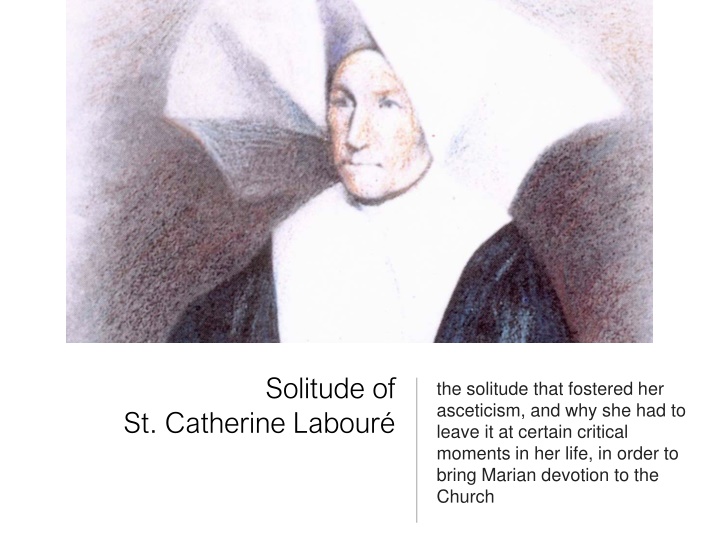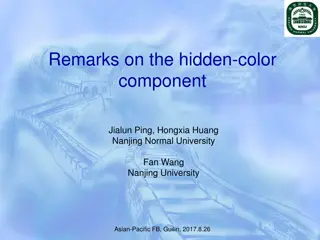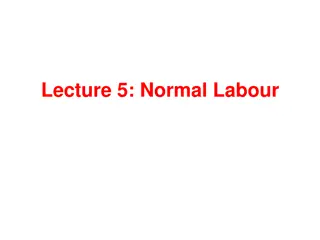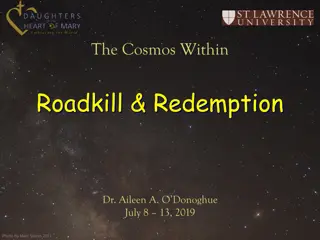The Hidden Life of St. Catherine Labouré and the Mystery of the Miraculous Medal
St. Catherine Labouré led a life of solitude that nurtured her asceticism and devotion to Mary Immaculate, ultimately leading to the revelation of the Miraculous Medal. She kept her secret for 46 years, captivating her contemporaries with endless speculation. Despite the mystery surrounding her identity, her solitude was recognized as crucial for her sanctity and paved the way for her canonization.
Download Presentation

Please find below an Image/Link to download the presentation.
The content on the website is provided AS IS for your information and personal use only. It may not be sold, licensed, or shared on other websites without obtaining consent from the author.If you encounter any issues during the download, it is possible that the publisher has removed the file from their server.
You are allowed to download the files provided on this website for personal or commercial use, subject to the condition that they are used lawfully. All files are the property of their respective owners.
The content on the website is provided AS IS for your information and personal use only. It may not be sold, licensed, or shared on other websites without obtaining consent from the author.
E N D
Presentation Transcript
Solitude of the solitude that fostered her asceticism, and why she had to leave it at certain critical moments in her life, in order to bring Marian devotion to the Church St. Catherine Labour
46-Year Secret St. Catherine Labour was blessed with apparitions of Mary Immaculate, to which we owe the famous Miraculous Medal. For the forty-six years (from the year of the apparitions until her death), only she and her confessor knew who it was to whom the Miraculous Medal was revealed, despite many pressures she received to reveal the secret. The fact that Catherine kept her secret for so long created a sense of mystery, not just in the reflections on her life, but during her life.
Who is the favored one? The secret of her identity intrigued her contemporaries. Endless guesses, endless wondering, were made to find the sister who received the apparitions. There was something about someone living close by, maybe in the same house, who had been the favored soul of Our Lady to bring the Miraculous Medal to the world. Sister Rosalie Rendu was one of these Daughters of Charity who often passed the motherhouse treasuring devotion to the Miraculous Medal.
Recognized for canonization, in spite of secrecy It was Catherine's solitude that caught the eye of Cardinal Masella, prefect of the Congregation of Rites, in 1895, and set in motion the cause for her beatification. Fr. Antoine Fiat, C.M., Superior General of the Congregation of the Mission and the Daughters of Charity, had asked him for the celebration of "votive masses" without even mentioning the medal.
Recognized for canonization, in spite of secrecy (cont d) Cardinal Masella passed on the request but granted him the Little Office of the Medal including readings, relating to the apparitions. 27 November 1894 was the first liturgical feast of the medal. Cardinal Masella wrote to Fr. Fiat that "he was scandalized by the excessive modesty of the Vincentians. I censure them loudly. When are you going to introduce a canonization petition? She was an eminently saintly religious! If you won't do it, I will!"
Solitude: Critical for Catherine St. Catherine s biographer, Joseph Dirvin, C.M., maintains that without this solitude in Catherine's life, it is questionable that she would have been able to live a life of sanctity. The demands of being known as the favored one by Our Lady would have placed her in a position that would not allow privacy and hiddenness, and this would have been intolerable to her nature.
St. Catherines Youth Catherine was astonishingly contemplative from a young age. She loved to take care of the church and visit Fain Ie Moutiers' rural poor. She was quiet from her earliest years and seemed to love obscurity, treasuring moments of solitude.
Protection from the Limelight Laurentin and Dirvin both suggest in their accounts of her life that Our Lady protected her from the suffering of being placed in the limelight from the apparitions: "Catherine herself in the last months of her life... said to her superior: "Since I haven't much longer to live, I feel that the moment to speak out has come. But, as the Blessed Mother told me to speak only to my confessor, I shall say nothing to you until I have asked Our Lady's permission in prayer."
Struggle for Fulfillment of Mary s Requests The irony of Catherine's solitude was that it was also her greatest suffering in the continuous and strained refusals on the part of Father Jean Marie Aladel, C.M., Sister Dufes, and Father Jules Chinchon, C.M., to fulfill the requests of Blessed Mother through her. Catherine had to wait two years for the medal to be struck through the intervention of Father Aladel and forty years for the statue of the Virgin with the globe (Virgo Potens). Jean Marie Aladel, C.M.
Interior Struggle Coste points out that because the statue of Virgo Potens was not cast as soon as the Miraculous Medal was, there began an interior struggle for Catherine. She served the aged and infirm in Reuilly, yet she wanted to bring to the world the Virgo Potens statue. St. Catherine s quarters at Reuilly
Patience The vision of the Miraculous Medal was 27 November, 1830. Catherine was twenty four years old. She confided to Father Aladel the request of the Blessed Mother. Assigned to Reuilly in January 1831, several months went by and the medal was not made. Our Lady sent a message to Father Aladel: "A day will come when Father Aladel will do what I wish. He is my servant and he would fear to displease me."
Pressure on Fr. Aladel to decide Father Aladel's task was made doubly difficult by Catherine's insistence that her identity remain secret. He alone was responsible for the task because he could not have her testify to a competent ecclesiastical tribunal. Aladel alone had to decide upon Catherine's character and reliability.
Vierge du jardin, at Reuilly Other Apparitions Father Aladel was not idle during the time that the statue of Virgo Potens was delayed. On the contrary, he was instrumental in bringing both devotions of the Green and Red Scapulars in honor of Blessed Mother to the Church. In 1840, Our Lady appeared to Sister Justine Bisqueyburu, to give her the Green Scapular and in 1846, appeared to another Daughter of Charity, Sister Appolline, for our Lord in His Passion, and the Red Scapular.
Virgo Potens Father Aladel seemed quite content with the success of the Miraculous Medal bringing great devotion to our Blessed Mother. But Catherine attempted to speak with him in 1841 about the Virgo Potens statue, even bringing a drawing of the apparition, but it did not materialize at that time. "For ten years, I have felt myself driven to tell you to have an altar erected to the Blessed Virgin on the spot where she appeared. Every indulgence will be granted. Ask, ask; everything you ask will be granted." Watch Virgo Potens video here
Challenges In 1860, Sister Jeanne Dufes came to Enghien as Sister Servant. She was to be a source of trial and suffering for Catherine. From their first encounter, these two women felt a natural antipathy to each other. The basis of it lay in the fact that they were very much alike. Both were practical, competent women of irascible temperament." Providentially, Sister Dufes was to prove the perfect way to break every last vestige of self-love and self-will in Catherine.
Managing her emotions Catherine could regain calm faster than Sister Dufes. Sister Dufes captures this, herself, when she says "She is as hot, or quick- tempered, as milk-soup. I do not know how she is able on an instant to capture such absolute calm." Like many other Saints, Catherine was able to overcome a natural tendency to be hot-tempered. (Indeed, St. Vincent de Paul himself said that except for the grace of God he would have been "hard and repulsive, rough and cross.")
Despised and rejected, as Jesus was One of the Daughters of Charity at Reuilly had testified: "Sometime between 1864 and 1873, Fr. Chinchon [her confessor at Reuilly] publicly humiliated Sr. Catherine. He told her off for wanting to pass off her dreams as reality and ridiculing an entire community. Sr. Catherine remained humble, quiet, in her place without replying nor showing any sign of discontent...
Able to leave her solitude, for Mary It seemed that with failing health, time became precious for Catherine, and she was able to leave her solitude and try to bring to reality the Virgo Potens statue. Sister Dufes refused the request, but told Catherine she suspected she was the recipient of the Miraculous Medal. Catherine then prayed to Blessed Mother and afterwards revealed to Sister Dufes what was needed for the Virgo Potens statue. After consultation with major superiors, Sister Dufes did have the statue struck.
Knowing the right times to leave her solitude Thus, the mission that Blessed Mother gave Catherine had her leave the solitude that fostered her asceticism, at certain critical moments in her life, in order to bring Marian devotion to the Church.
Source: The Solitude of St. Catharine Labour by Frances Ryan, DC http://via.library.depaul.edu/cgi/viewcontent.cgi?artic le=1142&context=vhj























